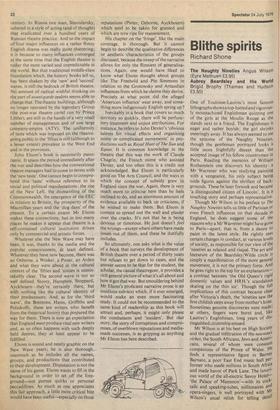Blithe spirits
Richard Shone
The Naughty Nineties Angus Wilson (Eyre Methuen £3.95) Aubrey Beardsley and His World Brigid Brophy (Thames and Hudson £3.50)
One of Toulouse-Lautrec's most famous lithographs showsa top-hatted and vigorously moustachioed Englishman quizzing one of the girls at the Moulin Rouge as she stands next to a friend. The Englishman is eager and rather boyish; the girl shrinks sneeringly away. It has always seemed to me the epitome of the Naughty Nineties, though the gentleman portrayed looks a little more frightfully decent than the accepted image of his fellow countrymen in Paris. Reading the memoirs of Willian1 Rothenstein one discovers his identity: a Mr Warrener who was studying painting with a vengeance, his only subject being nude figures against the shrillest of backgrounds. These he later forsook and became 'a distinguished citizen of Lincoln'. It is a touching story and perhaps representative.
Though Mr Wilson in his preface to The Naughty Nineties tells us little of Parisian or even French influences on that decade in England, he does suggest some of the reasons why a Mr Warrener might have gone to Paris—apart, that is, from a desire to paint in the latest style. He rightly sees certain changes in conduct, at various levels of society, as responsible for our view of the 'nineties as relaxed and risque. The art and literature of the Beardsley/Wilde circle Is simply a manifestation of the more general movement, it is not the primary force. And he goes right to the top for an explanation a contrast between 'the Old Queen's rigid domestic values and HRH.'s scandalous skating on the thin ice'. Though the full implications of this contrast became clear after Victoria's death, the 'nineties saw the first childish steps away from mother's knee. Sometimes genuine discoveries were made; at others, fingers were burnt and, like Lautrec's Englishman, long years of distinguished citizenship ensued. Mr Wilson is at his best on High SocietY and the gradual infiltration of the nouveauX. riches, the South Africans, Jews and Americans, several of whom were constant companions of the Prince of Wales. He finds a representative figure in Barney Barnato, a poor East End music hall performer who made millions in South Africa and made havoc of Park Lane. The luxurlous world of the all-electric Savoy Hotel-`the Palace of Mammon'—with its cock' tails and speaking-tubes, millionaires and opera-singers, is well portrayed with NI!, Wilson's usual relish for telling detail
(reflected in the photographs and their sometimes enigmatic captions). At the risk here of seeming irrelevant, might I make a Plea with some enterprising publisher, if such a person still exists, for the re-issue of some of the abundant memoirs of the Period, headed of course by that masterPiece of wit and sanity, Embassies of Other Days, by Walburga, Lady Paget and including that other gem Daisy, Princess of Pless by Herself? Mr Wilson generally invokes the mainstream—the plays of Wilde, The Diary of a Nobody and The Awkward Age. But this is frequently at the expense of the visual arts, and amends are not made in the reproductions. Surely Sickert might have found a niche, and Conder too; both are more appropriate than Morris and Burne-Jones.
For more detail about 'the most original genius of the Nineties', we turn to Brigid Brophy's Beardsley and His World. And detail is about all we get. Mr Wilson's breathy preface gives the impression of having been lightly smeared while still wet ; but at least it was wet. Miss Brophy crawls through her material leaving its bones Showing. We are treated to the mechanics of biographical research as though they, too, Were original discoveries: 'I had just framed this hypothesis when it was confirmed, by a letter from the present headmaster of the school: In a book which, like its companion volumes, is intended to be a succinct portrait of a man and his times, there should be no room for such passages and Miss Brophy takes them too far in the tedious and fussy dialogue she pursues with Beardsley's early hagiographer R. A. Walker. However, she has discovered several new facts about Beardsley and for these we must be duly grateful. But when, half-way through her narrative, Brophy writes, 'Cultivated, dandified and a born master of high camp, Beardsley fitted easily and wittily into Wilde's ambience', we are unprepared. The prePonderance of aunts, wills, and addresses had excluded any construction of character.
While Miss Brophy is not exactly prudish there is a restraint in her writing, bordering O n the puritan, which only disappears when She indulges in some dubious passages of critical analysis. One of the more astonishing of these concerns Beardsley's use of black and white, which she sees as a symbolic drama between the black threat of death and the white light of his art—the former about to engulf the4atter. There is usually a much greater separation between an artist's life and his work than we imagine, and while some of Miss Brophy's speculations are undoubtedly interesting, she seems to have fallen into the common error of a too recklessly literary interpretation. Fortunately, the drawings speak for themselves. But it is a pity that no room was found for one or two of the by no means inferior Obscene drawings. Instead we have several Perfectly mundane photographs of houses in London and Brighton (cars included) Which add little to our knowledge of this 'Pra Angelico of Satanism'.



































 Previous page
Previous page